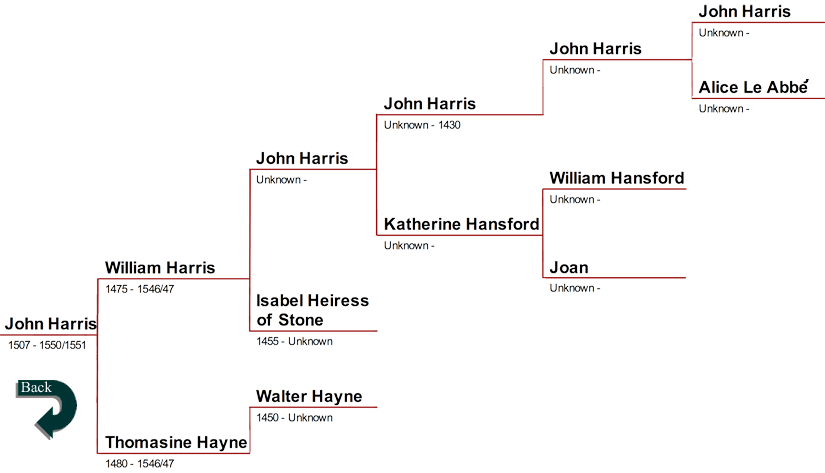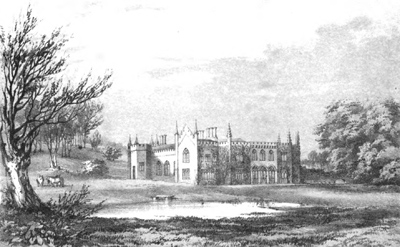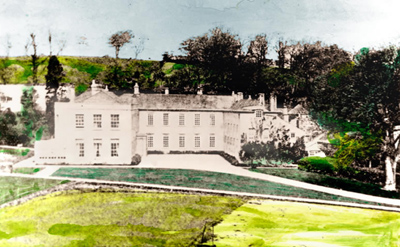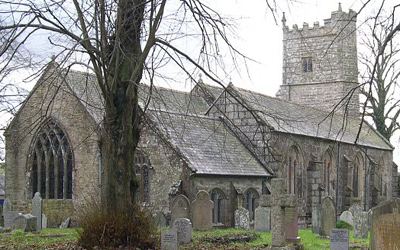John Harris' Ancestors |
Click on a name for info, click on an arrow to follow that branch, click Home to go to the main page, or click for an Alphabetic List of all Names. |

|
| Note: Before 1752 the year began on March 25th. Dates between January 1st and March 24th were at the end of the year, not the beginning. |
William Harris was born about 1475, the only son of five children born to John Harris and Isabel, his wife, who was the Heiress of Stone of Lifton. Thus William became the Heir of Stone of Lifton and lived in the south of Devonshire, near Plymouth, close to the land wealthy Haine family. Like his father before him, William married a female heiress, Thomasine of Haine. Thus he obtained the title, Heir of Stone and Hayne. (After this marriage, the name became Hayne.) They had only two known children, see Thomasine’s bio for more about them. There are many records in the Devon Archive Catalogue, that mention his name, beginning in 1508, where he is a witness to a Lifton; Beara: Quit claim and ending in 1538, where he is listed as William Harris of Lifton, gent. Most of the records in-between these dates call him William Harris of Stone, gent., and deal with deeds and quit claims in Lifton-Beara and other unnamed tenements; Lamerton; and the Broadwoodwidger- Naithwood tenement. The most interesting one is dated in 1522 and is a Deed of gift in the Lifton-Cookworthy tenement from John Saunder to “William Harris and Thomasia his wife, John White and Johanna his wife.” The gift will revert to John Saunder, if Johanna and her husband “die without legitimate heirs of the body.” What makes it interesting is that no relationships are mentioned, so it is not known how the Whites are connected to the William and Thomasine. Not much else is known of William, but both the The Visitations of Cornwall and Devon state he died on January 12, 1547, after his wife. There are two Inquisition Post Mortem (IPM) records in The UK National Archives, both taken in Devon between April 22, 1546 and January 28, 1547, which suggests he died in the later part of 1546. One IMP is in the Chancery records and the other is in the Escheators' files. Both simply list him as Harris, William: Devon. |
| ~< Back to Chart >~ |
|
Thomasine Hayne was born about 1480 in Hayne, Devonshire, England, the only child of Walter de Haine and his unknown wife. Their surname was Haine at the time of her birth. Her given name has been recorded as Thomazin, Thomasin, as well as Thomasine in various different books, but all sources call her daughter and heiress of Walter of Hayne. Sometime between 1497 and 1506, she married William Harris, the eldest son and heir of Stone, and a neighbor to the Haines. This is about when the name changed to Hayne. Thomasine and William had two children – ancestor John and a daughter named Wilmot or Wylmott, who married William Foster of Hole in Devon. We know that Thomasine Hayne Harris died before her husband, as she is listed on his death inquest as deceased in 1547, during the reign of Henry VIII. Sometime later, during the reign of Queen Elizabeth (after November 17, 1558), a special grant confirmed the manor and royalties of Haine to the issue of Thomasine, as being the lineal descendant of Hugo Mortimer de l'Haine (see her father’s bio for more on this). In his book A Visitation of the Seats and Arms of the Noblemen and Gentlemen of Great Britain, Sir Bernard Burke states that this reconfirmed Thomasine’s descendants “the office and privileges of high or chief warrener of Dartmoor Forest. . . If Hayne were to be sold, the manor might be transferred to the purchaser, but the royalties would cease. . .” That is the rights and royalties of Haine would revert to the Crown. |
| ~<^>~ |
John and Isabel were probably both born in the 1450’s. Not much is known about them, except that they had one son, ancestor William and four daughters. These daughters are not individually named in any books, they are simply listed as four daughters, married to Piper, Jackman, Cole, Allen. Unfortunately, nothing more is known about them, not even the names of Isabel’s parents. |
| ~< Back to Chart >~ |
Walter Hayne was probably born about 1450 at Hayne in Devonshire, England. Nothing is known about him directly, except that he had only one child, ancestor Thomasine. There was another Walter Hayne living in the area that could have been his father or uncle, who was age 30 on July 15, 1435 and was mayor of Barnstaple in 1447. Unfortunately there is not a link to our Walter. Fortunately, in the second volumes of two books by Sir Bernard Burke, we learn of ancestor Walter Hayne’s Norman connection. The first book, The Historic Lands of England, was published in 1849 and his other book in 1853 was called A Visitation of the Seats and Arms of the Noblemen and Gentlemen of Great Britain. Both books contain the same text and tells us an interesting story-condensed here: “In Domesday Book the manor of Stowford is registered as belonging to ‘Hugo comes,’ the son of Robert, Earl of Mortain and Cornwall, a uterine brother of the Conqueror. On the maternal side he might boast of a descent scarcely less illustrious, his mother being Matilda, daughter of Roger de Montgomeri.” This affirms that Robert and William the Conqueror had the same mother, but not the same father. Burke continues to explain that Roger, who was now known as Baron Roger de l'Eaulne, was disgraced in the battle of Mortimer. William banished Roger and gave his land and title to Roger’s grandson, Hugo (or Hugh) who was Robert’s son and William’s nephew. Hugo took on the surname of “Mortimer de l'Eaune. Thus attached to Duke William as much by gratitude as by kinship, Hugo accompanied his uncle in his invasion of England, and conducted himself with so much skill and courage that he has earned what men love to think a lasting record both in romance and chronicle.” Burke tells us that “The father of our Hugo, the Earl of Mortain, had also played a conspicuous part at the battle of Hastings, for which he reaped an ample recompense in the division of the spoil that followed, . . .” William, now King William of England, gave Robert “no less than seven hundred and ninety-three manors” and created and made Robert Earl of Cornwall. In turn Robert gave his son Hugo “the manor of Stowford, and other lands in that neighbourhood.” Hugo “settled there, and called the Castle appertaining to it by his own Norman name of De l'Eaulne; this appellation in time came to be corrupted into Eaune—Ayne—and Hayne, by which last title it is known at present. From this period it continued in the possession of his descendants until the beginning of the sixteenth century, when Thomasine, the heiress of Walter of Hayne, married the son of Harris of Stone, who had obtained that property in the same way that his son now became possessed of Hayne, that is, by intermarrying with the heiress. He was himself a younger son of the Radford family.”
It should be noted here that there are many books about The Conqueror, with many different opinions of who was with him when he came to England and who they were. Unfortunately, none but Burke brings the ancestry down to Hayne. Other researchers believe the family is of Saxon origin. In a Haines ancestry compilation by Richard and George Haines, it states that John Haines, of Totness, Devonshire, England believed the family was well established in England before William the Conqueror. His account is: “William, upon his arrival in England, found the family settled in ‘Hayne,’ in the Parish of Stowford, near the Tamar, on the borders of Cornwall. They existed as a clan, and were possessed of immense tracts of land in Devonshire and Cornwall. There was a castle on their lands called ‘Hayne Castle,’ which name the modern mansion still retains, from the ancient ruins near it. There is also a river called ‘Hayne’ running into the Tavy, and a tower on Dartmoor called ‘Hayne Tower.’ So it appears even at that time the family was one of importance in the country. William took one-half of their lands, which he gave to his followers, the other half was entered in Doomsday Book as the property of the ‘Clan Haineses.’ Since that time the family continued of importance, as many of their chiefs filled the office of High Sheriff of the county — an office at that time of great importance, as the incumbent was the representative of the King, led the yeomen of the country to battle, and was the head of the county. This continued until 1600, when the estate devolved on an only daughter, Tameson Haines, who married a man by the name of Harris, of Cornwall, who was likewise upon his marriage made High Sheriff of the county. From that time until 1870, the property remained in the Harris family, who were known by the name of Harris of Hayne ; when it was sold to pay debts incurred by that family. It also appears that at the time of the marriage of Tameson Haines, a disruption of the family took place ; they feeling that their head was gone and a stranger seated in the halls of their fathers ; and this was also undoubtedly assisted by religious differences, which at that time began to creep into families.” We know that it had to be in the very late 1400 to early 1500’s when Thomasine married John Harris, so this account is flawed. Not knowing how much of the rest is true is unknown, so our line ends with Walter. |
| ~<^>~ |
John Harris is the son of John Harris and an unknown mother and was the third Heir of Radford. He married Katherine, the Heiress of Hansford and expanded his lands. They had at least two sons, both named John. The older John was known as John Harris of Radford, he died on October 16, 1485. Ancestor John, was called his younger brother and later became John Harris of Stone. According to the Harris Ancestors website, John Harris died about 1430. Unfortunately nothing else is known about him. |
| ~< Back to Chart >~ |
Katherine Hansford is said to be the daughter of William and Joan Hansford, born in the village of Ashreigney in Devon, England, 15 miles south of Barnstaple. Researchers have placed her birth from 1370 to 1400 and call her the Heiress of Hansford. Documents held at the Devon Record Office and indexed online in The National Archives, confirm the fact that a Katerine de Hansford was alive in 1442, as she leased the Land at Clyffe in Burrington to Roger atte Clyffe and Alice his wife for 10s. (shillings) for 120 years. In that same packet of documents, but earlier in time, is the mention of her father, William (see his bio for more on this). Katherine married John Harris and had two sons named John. Although a few researchers say Katherine Hansford Harris died in 1489, it seems unlikely. It is not known when or where she died and was buried, but it probably was in the Ashreigney area in Devonshire. |
| ~<^>~ |
John Harris was the son of John Harris the first of Radford and Alice Le Abbé, the Heiress of Radford. In The Visitation of the County of Devon in the Year 1564 he is listed as “. . . Harrys of Radford, gentl.” The Visitations of the County of Devon: Comprising the Herald's Visitations of 1531, 1564, & 1620, lists him as “John Harris of Radford near Plymouth, temp Hen V,” which means he was alive during the reign of King Henry V, which was from 1413 to 1422. He is mentioned only by name in other books, but unfortunately, nothing else is known about him. |
| ~< Back to Chart >~ |
William Hansford’s ancestry is unknown. His surname has been spelled Hankesford, Hantisford, and Hanchford in various books. Many researchers believe his wife’s name was Joan, but nothing else is written about her. (It is believed that many records for this time period including wills, registers and other useful documents were lost in the Exeter blitz.) They had at least one child, ancestor Katherine in Ashreigney, Devon, England. The National Archives online index states that there are documents held at Devon Record Office that concern William Hansford. The two that are partially accessible online are in reference number 1049M; were created by the Church of England, Shobrooke Parish, Devon; and they both concern a gift of land. The first is dated 1391 and is numbered 1049M/T 12. It names John More de Raddon and William de Hamptisford (William Hansford) and appears to be about a gift of land in More. One researcher, named Ann, on the Hansford-L Archives website believes this land “could be Burrington More/Moor in the neighbouring parish of Burrington. . . . Hansford Barton and Hansford Cross are in the north of the parish of Ashreigney, near the border with Burrington. (Apparently, Hansford Barton is mentioned as early as 1205). There is also a place called Handford in Burrington, which might relate to the same family.” The second record is numbered 1049M/T 13-14, and is dated 1397 - 1398. It names William de Hansford and Henry atte Clyve and Joan his wife and concerns “His lands in Clyve, Crookerisclyve and Clorkeshulle, Burrington; parcel of land and Melibrook in Ashreigny.” It seems the land they are talking about belonged to William. The only other reference to William Hansford was found in John Burke’s, A Genealogical and Heraldic History of the Commoners of Great Britain and Ireland, volume II, which under Cary of Torr Abbey reads “Sir Robert Cary . . . m. secondly, Jane, Daughter of Sir William Hanchford, knt. and widow of --- Wadham.” It is not certain that this is our ancestor, but being that this was in Devon, it could be. The Harris Ancestors website believes that Jane and Katherine were sisters. Unfortunately nothing more is known about William Hansford. |
| ~< Back to Chart >~ |
John Harris is the furthest back in our Harris line that we can go - his ancestry is unknown. What we do know is that he married heiress Alice Le Abbé, widow of Henry Beauchamp and obtained (some say inherited) the lands in Plymstock, Whitchurch, Aveton Giffard, and Radford (mouse over image right), in the early to mid 1400’s. This is documented in reliable and separate publications such as Ivy Langdon’s Plymstock Connection; Reverend CC Shaw’s History of Aveton Giffard; and Sir William Pole’s Collections Towards a Description of the County of Devon.
|
| ~<^>~ |
Alice Le Abbé’s direct ancestry is uncertain, although we know much about her ancestral family. Some researchers say she was the sister of Walter de Radford, and the daughter or granddaughter of Walter Radford who was first married to Mabel Treverbyn, and held the lands of Radford in 1346. Some researchers say her mother was Joan Trewin, possibly the second wife of Walter. This gets even more confusing by the fact that the family used alias for surnames - Treawen and Trewin are two that are found in records and the name Abbot is used in books (Abbé is the French word for Abbot). Most of the records are land deeds, which do not confrim parentage, but rather follow the land as it was inherited from one person to another - not just father to son or daughter, but uncle to niece and so forth. So clearly identifying her parents is nearly impossible.
Alice married Humphrey, second son of Hugh Beauchamp of White Lackington in Somerset. Apparently her husband died, she remarried, and she gave two of her manors to her son, Hugh Beauchamp. In the book Devonshire Wills, author Charles Worthy says, “Alice Abbott, described as ‘now wife of John Strokysdone’ granted the Manors of Washfield and Loughtor to her son, Hugh Beauchamp, with the advowson of Washfield Rectory, by deed dated 36th Edward III (1362).” It is assumed by these marriages she gained even more land. Her second husband must have died or she divorced him and married ancestor John Harris. Thus all her land that she did not already give away, became his upon her death. Researchers believe that the Harris of Radford land came to the Harris family through the families of Le Abbé, Radford, Giffard and Dinham. |
| ~< Back to Chart >~ |
 John Harris was born to parents John Harris and his wife Katherine Hansford. He was the younger of two sons named John. In many books he is called the younger brother of John Harris of Radford. He married a daughter and heir of Stone of Lifton (mouse over image right), whose name is believed to have been Isabel. Upon the marriage John became known as John Harris of Stone, while his older brother John retained the family title of John Harris of Radford.
John Harris was born to parents John Harris and his wife Katherine Hansford. He was the younger of two sons named John. In many books he is called the younger brother of John Harris of Radford. He married a daughter and heir of Stone of Lifton (mouse over image right), whose name is believed to have been Isabel. Upon the marriage John became known as John Harris of Stone, while his older brother John retained the family title of John Harris of Radford. Burke continues with, “The ancient castle of Hayne, the seat of so many recollections, stood upon a lofty eminence in the park, called the Warren, and in the beginning of this century some vestiges of it were still visible. It is supposed the old walls were pulled down, with more economy than taste, at the end of the fourteenth or beginning of the fifteenth century, to supply materials for the present mansion, but in what precise year this destructive work took place is now uncertain.” (Mouse over image right.)
Burke continues with, “The ancient castle of Hayne, the seat of so many recollections, stood upon a lofty eminence in the park, called the Warren, and in the beginning of this century some vestiges of it were still visible. It is supposed the old walls were pulled down, with more economy than taste, at the end of the fourteenth or beginning of the fifteenth century, to supply materials for the present mansion, but in what precise year this destructive work took place is now uncertain.” (Mouse over image right.) There is a good possibility that John Harris is a descendant of an Anglo-Norman family who arrived in England at the time of the Norman invasion in 1066, possibly Hugh de Hericey (Herise or Heriz), who settled at Nottingham. Bob Harris on his website tells us that “Some research papers indicate that Hugh was a descendant of Ancelin or Lancelin de Beaumont who went to England and held a Barony in Nottingham about 1086 A.D. Ancelin was the son of Herise (circa 996-1031), son of Landric de Beaugency of Orleands France.” Bob Harris also gives names of possible descendants of Hugh who lived in the northern part of Devon and Cornwall as: Henricus (or Henry) de Herys in about 1189-1199; Robert de Heriez in 1200 and 1201; Henry Heriz in 1238; a John and Richard Herice and Hugh, Richard’s son from 1250 to 1294; Roger Heriz in Hode; William de Herisi and his son Richard in 1250; Thomas Harry in Tremaly and Tremalyle Down in the 1300s; Roger Heriz in central Devon in 1326; a family named Herry in Devon near Plymouth in 1328; a John Harry in 1371 to 1375; a William Herry in 1386; and a Nicholas and Warin Harry in the early 1400s. So any one of these men could have been our John’s ancestor. A more detailed account is given on Bob Harris’ wonderful website,
There is a good possibility that John Harris is a descendant of an Anglo-Norman family who arrived in England at the time of the Norman invasion in 1066, possibly Hugh de Hericey (Herise or Heriz), who settled at Nottingham. Bob Harris on his website tells us that “Some research papers indicate that Hugh was a descendant of Ancelin or Lancelin de Beaumont who went to England and held a Barony in Nottingham about 1086 A.D. Ancelin was the son of Herise (circa 996-1031), son of Landric de Beaugency of Orleands France.” Bob Harris also gives names of possible descendants of Hugh who lived in the northern part of Devon and Cornwall as: Henricus (or Henry) de Herys in about 1189-1199; Robert de Heriez in 1200 and 1201; Henry Heriz in 1238; a John and Richard Herice and Hugh, Richard’s son from 1250 to 1294; Roger Heriz in Hode; William de Herisi and his son Richard in 1250; Thomas Harry in Tremaly and Tremalyle Down in the 1300s; Roger Heriz in central Devon in 1326; a family named Herry in Devon near Plymouth in 1328; a John Harry in 1371 to 1375; a William Herry in 1386; and a Nicholas and Warin Harry in the early 1400s. So any one of these men could have been our John’s ancestor. A more detailed account is given on Bob Harris’ wonderful website,  Alice, as well as having inherited the Radford, Whitchurch (mouse over image left), Aveton Giffard, and Washfield estates, also inherited the manor of Loughtor by Plympton, that had previously belonged to her Abbé family from her uncle Walter Radford (alias Treawen) on his death in the mid 1300s, sometime after 1343 and prior to 1362. Radford, a feudal manor, derived its name from the color of the soil and a ford over a brook. It is believed that the Abbé family settled there in the 13th century and William Le Abbé who married Cecily Giffard, adopted the name Radford as their family name. The manor of Plymstock belonged to Tavistock Abbey from a period before the conquest. Many believe that Washfield got its name because the river would overflow and wash out the low lands. The Aveton Giffard land came to her from Emma (nee Giffard) Dinham, who died in 1291 without descendants. Because of this wealth of land, Alice was an attractive match.
Alice, as well as having inherited the Radford, Whitchurch (mouse over image left), Aveton Giffard, and Washfield estates, also inherited the manor of Loughtor by Plympton, that had previously belonged to her Abbé family from her uncle Walter Radford (alias Treawen) on his death in the mid 1300s, sometime after 1343 and prior to 1362. Radford, a feudal manor, derived its name from the color of the soil and a ford over a brook. It is believed that the Abbé family settled there in the 13th century and William Le Abbé who married Cecily Giffard, adopted the name Radford as their family name. The manor of Plymstock belonged to Tavistock Abbey from a period before the conquest. Many believe that Washfield got its name because the river would overflow and wash out the low lands. The Aveton Giffard land came to her from Emma (nee Giffard) Dinham, who died in 1291 without descendants. Because of this wealth of land, Alice was an attractive match.